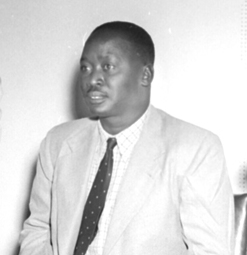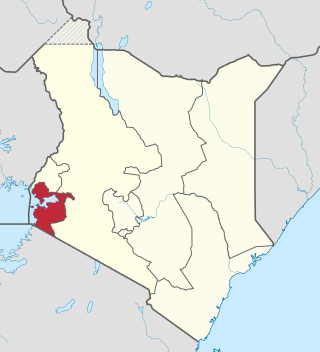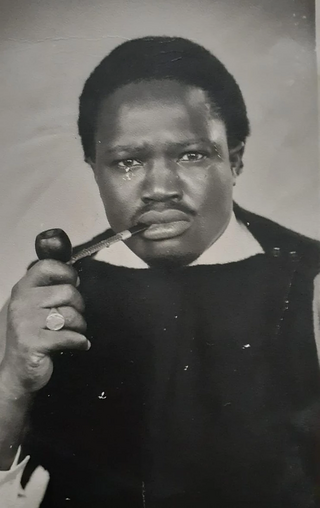
A part of Eastern Africa, the territory of what is known as Kenya has seen human habitation since the beginning of the Lower Paleolithic. The Bantu expansion from a West African centre of dispersal reached the area by the 1st millennium AD. With the borders of the modern state at the crossroads of the Bantu, Nilo-Saharan and Afro-Asiatic ethno-linguistic areas of Africa, Kenya is a truly multi-ethnic state.

The Kenya African National Union (KANU) is a Kenyan political party that ruled for nearly 40 years after Kenya's independence from British colonial rule in 1963 until its electoral loss in 2002. It was known as Kenya African Union (KAU) from 1944 but due to pressure from the colonial government, KAU changed its name to Kenya African Study Union (KASU) mainly because all political parties were banned in 1939 following the start of the Second World War. In 1946 KASU rebranded itself into KAU following the resignation of Harry Thuku as president due to internal differences between the moderates who wanted peaceful negotiations and the militants who wanted to use force, the latter forming the Aanake a forty, which later became the Mau Mau. His post was then occupied by James Gichuru, who stepped down for Jomo Kenyatta in 1947 as president of KAU. The KAU was banned by the colonial government from 1952 to 1960. It was re-established by James Gichuru in 1960 and renamed KANU on 14 May 1960 after a merger with Tom Mboya's Kenya Independence Movement.

Jaramogi Ajuma Oginga Odinga was a Kenyan politician who became a prominent figure in Kenya's struggle for independence. He served as Kenya's first vice-president, and thereafter as opposition leader. Odinga's son Raila Odinga is a former prime minister, and another son, Oburu Odinga, is a former assistant minister in the Ministry of Finance.

Kisumu is the third-largest city in Kenya after the capital, Nairobi, and Mombasa. It is the second-largest city after Kampala in the Lake Victoria Basin. The city limit has a population of slightly over 600,000. The metro region, including Maseno and Ahero has over 1.2 million people.

The Kenya African Union (KAU) was a political organization in colonial Kenya, formed in October 1944 prior to the appointment of the first African to sit in the Legislative Council. In 1960 it became the current Kenya African National Union (KANU).

Elections in Kenya take place within the framework of a multi-party democracy and a presidential system. The President, Senate and National Assembly are directly elected by voters, with elections organised by the Independent Electoral and Boundaries Commission (IEBC).

Nyanza Province was one of Kenya's eight administrative provinces before the formation of the 47 counties under the 2010 constitution. Six counties were organised in the area of the former province.
Henry Pius Masinde Muliro was a Kenyan politician from the Bukusu sub-tribe of the larger Abaluhya people of western Kenya. He was one of the central figures in the shaping of the political landscape in Kenya. A renowned anti-colonial activist, he campaigned for the restoration of multi-party democracy in Kenya in his later years. He was a ruthless negotiator and a proponent of peaceful but focused politics. He had a reputation for integrity rivaled only by Ngala. He was considered by some as one of the best leaders that never became president, it has been speculated that had he not died, he may have beaten Moi for the presidency in 1992.

The Luo of Kenya and Tanzania are a Nilotic ethnic group native to western Kenya and the Mara Region of northern Tanzania in East Africa. The Luo are the fourth-largest ethnic group (10.65%) in Kenya, after the Kikuyu (17.13%), the Luhya (14.35%) and the Kalenjin (13.37%). The Tanzanian Luo population was estimated at 1.1 million in 2001 and 3.4 million in 2020. They are part of a larger group of related Luo peoples who inhabit an area ranging from South Sudan, southwestern Ethiopia, northern and eastern Uganda, Chad, Central African Republic, Nigeria, northeastern Congo-Kinshasa, southwestern Kenya and northern Tanzania.

Raila Amolo Odinga is a Kenyan politician who served as the prime minister of Kenya from 2008 to 2013. He served as the Member of Parliament (MP) for Langata Constituency from 1992 to 2013 and has been the Leader of Opposition in Kenya since 2013. He is the leader of Azimio la Umoja–One Kenya Coalition Party.
The Orange Democratic Movement (ODM) is a centre-left political party in Kenya. It is the successor of a grassroots people's movement which was formed during the 2005 Kenyan constitutional referendum campaign. This movement separated in August 2007 into the Orange Democratic Movement Party of Kenya and the Wiper Democratic Movement – Kenya.

Ramogi Achieng Oneko (1920–2007) was a Kenyan freedom fighter and a politician. In Kenya, he is considered as a national hero.
The National Development Party (NDP) was a political party in Kenya which was of national importance between 1994 and 2001. It was founded by Stephen Wilfred Omondi Oludhe.
The Kisumu massacre occurred when the presidential guard and police forces shot and killed several civilians in Kisumu Town, the capital of Nyanza Province in Kenya. This took place on 25 October 1969. The official death toll from government sources stands at 11 fatalities but other sources place this number at closer to 100. Victims included women and children, some of whom were shot 30–50 km away from the epicentre of the riots. According to media reports, the government of the day made attempted to cover up the extent of the massacre.
Grace Monica Akech Onyango, popularly known as Nya'Bungu, was a Kenyan politician. She achieved several firsts in post-independence Kenyan politics, as the first female to climb up the ranks of the political system, defying cultural barriers. She was the first Kenyan female mayor, after she replaced Mathias Ondiek as the Mayor of Kisumu in 1965. She was also the first female Member of Parliament in post-independence Kenya after she was elected to represent Kisumu Town Constituency in 1969. In Parliament, Onyango was the first woman to sit in the speaker's chair as temporary deputy speaker, and served as Deputy Speaker from 1979 to 1984. Her political career ended after she lost her parliamentary seat in 1984.

The presidency of Jomo Kenyatta began on 12 December 1964, when Jomo Kenyatta was named as the 1st president of Kenya, and ended on 22 August 1978 upon his death. Jomo Kenyatta, a KANU member, took office following the formation of the republic of Kenya after independence following his efforts during the fight for Independence. Four years later, in the 1969 elections, he was the sole candidate and was elected unopposed for a second term in office. In 1974, he was re-elected for a third term. Although the post of President of Kenya was due to be elected at the same time as the National Assembly, Jomo Kenyatta was the sole candidate and was automatically elected without a vote being held. He died on 22 August 1978 while still in office and was succeeded by Daniel arap Moi.

The 2018 Kenya handshake was a political truce made on 9 March 2018 between the then Kenyan President, Uhuru Kenyatta and former Kenyan Prime Minister, Raila Odinga. The two had been the leaders of opposing political factions amidst widespread political violence and civil unrest, and they had faced one another in the contested 2017 Kenyan general election. Under the "handshake" agreement, both figures agreed to end their political feud.

Ochola Ogaye Mak'Anyengo, also known as George Philip Ochola (1930–1990) was a Kenyan trade unionist and Member of Parliament for Ndhiwa, South Nyanza, Kenya. He was involved in the fight for Kenya's independence and was a beneficiary of the Mboya-Kennedy airlifts.
The Nairobi People's Convention Party (NPCP) was a Nairobi based political party formed in 1957 by Tom Mboya. This party played a crucial role in the fight for Kenya's independence. Despite attempts at suppression from the colonial government, the NPCP managed to mobilise Africans in Nairobi to further the nationalist cause and fight for independence from Britain. Following Jomo Kenyatta's release from detention in 1961, the NPCP merged with the Kenya African Union (KAU) and Kenya Independence Movement (KIM) to form the Kenya African National Union (KANU).
The Luo Union was a welfare organisation formed in Nairobi, Kenya, in the early 1920s. This organisation sought to create, expand and govern a general cultural identity among Luo people in East Africa. Luo people are a Nilotic ethnic group native to western Kenya and the Mara Region of northern Tanzania in East Africa. The Luo Union was one of several welfare organisations started during the colonial period in East Africa which aimed at building broad cultural unity. This organisation played a crucial role in creating a collective sense of identity and unity amongst Luo people after the second world war. It was also an important medium of grassroots political support for African Nationalist movements in the 1950s. The Luo Union FC was the unions soccer club. This club would later become Gor Mahia FC, one of Kenya's best performing football clubs.












